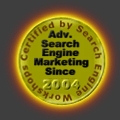 Look how old this is!
Look how old this is! I post at SearchCommander.com now, and this post was published 15 years 2 months 28 days ago. This industry changes FAST, so blindly following the advice here *may not* be a good idea! If you're at all unsure, feel free to hit me up on Twitter and ask.
I can’t even begin to count the number of WordPress blogs that I’ve set up personally, much less count how many have been done by various members of our team.
We used to use an actual checklist, to ensure that everything was done the right way with consistency, and for optimal visibility in the search engines.
Now, the entire checklist has been converted to a free WordPress plugin and the entire setup process is pretty much automatic!
Literally dozens of hours have been spent doing the same repetitive and mundane tasks, ranging from changing default permalink structure to renaming the default category from “Uncategorized”.
It’s not that any of it is particularly difficult or technical, it’s just that it’s unnecessarily time-consuming.
Why do something manually if you can automate?
Our typical checklist for a new WP blog setup includes:
- Changing the default post category name from “Uncategorized”
- Changing the default blogroll category name from “Blogroll”
- Deleting the default “Hello World” post
- Deleting the default comment on the Hello World post
- Change permalink structure to custom setting recommended by Scott & others
- Setting the Main Blog Email for convenience
- Setting the Admin User’s Email for convenience
- Change the name of the default page that WordPress adds from “About”.
- Set that default page to the static front page of the blog if using WP as a CMS
- Addding and setting which page displaying the posts for convenience
- Changing the article feed to either summary or full text
- Removing all the blogroll links that are auto-installed by WordPress
- Changing the RSS widget to offer “no-follow” and “open in new window” options
- Changing the blogroll links to more easily be no-followed and the default to open in a new window
Additionally, through the use of various plug-ins there are ways to make WordPress far more search engine friendly and user-friendly, for creation of not only blogs, but entire websites.
Some things simply can’t be improved upon, and to this day I’ll probably always use either the All in one SEO or Headspace to rank higher, in the same way I’ll always use the XML Sitemap plug-in.
But using WordPress as a content management system requires a bit more finesse, and there are some great plug-ins that allow you to control what your users sees on your menus, and you can have a far better web presence than “just” a blog.
Being able to determine the order of your pages on the menu, or even whether they should appear on the menu at all was always a frustration, and has kept many people from using WordPress to create entire websites easily.
When I began looking for ways to control these options, I ultimately settled on several plug-ins that I really liked.
The first was Page Order, which easily allows you to determine the order of the pages that appear on your menu
The second was page link manager, which adds an admin panel to choose which pages appear in the site navigation.
And of course, the third was Post teaser, which made it far easier for the layperson to limit the number of characters that appeared on a category page, archive page, or on the index page of a blog for each post. It’s better for several reasons to have just a snippet of text, and a contextual link to the rest of the post.
Well now, this can all be accomplished with the use of a single Worpress plug-in, that I’m calling my WordPress Core Tweaks, and it will will continue to evolve regularly.




















I have been wondering if there was a way to make a static page the home page on WP and to use it more like a regular website. Thanks for the tips.
I tend to forget to change the words “Just another WordPress blog” too. I also usually set the blog for no comments or install Akismet and forget to do that when starting.
I look forward to using your plug in on new sites.
Thanks Julie, and you’re right – not including that was an oversight, and it will be added to the next version…
Thanks for this plugin.I have setup many blogs like you have and I think this plugin is going to come in handy for me in the future.
That’s a good checklist. One of the plugins I like to use for my installations is cforms II, which makes contact forms easy to create and manage.